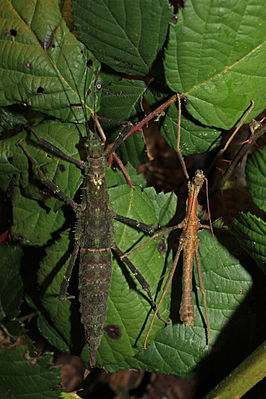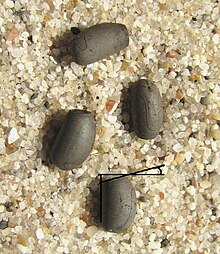Brasidas samarensis
| Brasidas samarensis | ||||||||||||
|---|---|---|---|---|---|---|---|---|---|---|---|---|

Brasidas samarensis , |
||||||||||||
| Systematics | ||||||||||||
|
||||||||||||
| Scientific name | ||||||||||||
| Brasidas samarensis | ||||||||||||
| Rehn, JAG & Rehn, JWH , 1939 |
Brasidas samarensis is an uncommon according to their origin as Samar-Stick Insect called stick insects - sort of the family Heteropterygidae . It belongs to the genus Brasidas , which was named after the Spartan general Brasidas .
features
The females of Brasidas samarensis are about 10 to 11 centimeters larger and wider than the approximately 5.5 to 7 centimeters long males. They are colored very individually, with mostly brown colors dominating, which are often interrupted by green areas. In the more vividly drawn nymphs , the green areas still take up large parts of the body. The male nymphs are also mostly green with a few brown areas. The adult males are only slightly prickly and often almost completely brown in color. Only the head is usually pale green and often has an intense green spot on the forehead. In terms of habit , both sexes correspond to the representatives of the Obrimini (e.g. Trachyaretaon carmelae ). As with all members of the genus Brasidas , a pair of characteristic holes can be found in the metasternum of this species .
Occurrence, way of life and reproduction
The occurrence of Brasidas samarensis is limited to the Philippine island of Samar , to which the specific epithet also refers.
The diet consists of leaves of guava and various other plant species. To lay their eggs, the females pierce the end abdomen ( abdomen ovipositor located) that the actual ovipositor surrounds the floor and place the eggs in it. These are around four to five millimeters long and two to three millimeters wide. Their gray color changes to dark brown with high humidity or contact with water. After drying, they are gray again. In the lateral view , the ventral edge appears straight, while the dorsal area is bulbous. The resulting opercular angle from the lid ( operculum ) to the ventral edge is 10 to 12 degrees (see also the construction of the phasmid egg ). The nymphs hatch from the eggs after about four to five months, even when there is less moisture. After another six months, the animals are adult and can then live for up to a year.
Terrariums
The first strain in the terrariums of enthusiasts goes back to the animals collected in Bobon in 2002 . The species is listed by the Phasmid Study Group under PSG number 235.
Brasidas samarensis is not difficult to keep. It can be cared for at room temperature and is easy to feed on raspberry or blackberry leaves all year round . Alternatively, oak , wild rose , hawthorn or hazelnut leaves can also be fed. Occasionally the forage plants should be sprayed with water. So that the females can lay their eggs in the ground, a slightly moist substrate is necessary, which should cover the floor of the terrarium a few centimeters high.
Web links
- www.phasmidenworld.de - Pictures of Brasidas samarensis
credentials
- ↑ a b Alexander Esch: stick insects, ghosts, walking leaves: successful keeping of phasmids . Natur und Tier-Verlag, Münster 2012, p. 54, ISBN 3866592213
- ^ A b Roy Bäthe, Anke Bäthe & Mario Fuß: Phasmiden , Schüling Verlag, Münster 2009, pp. 94–95, ISBN 978-3-86523-073-7
- ^ Paul D. Brock : Phasmida Species File Online . Version 2.1 / 3.5. (accessed on March 19, 2010)
- ↑ Phasmids in cyberspace about Brasidas samarensis (incl. Pictures)
- ↑ Phasmid page by Frank H. Hennemann & Oskar V. Conle ( Memento of the original from May 2, 2011 in the Internet Archive ) Info: The archive link has been inserted automatically and has not yet been checked. Please check the original and archive link according to the instructions and then remove this notice.
- ↑ Phasmid Study Group Culture List ( Memento from December 5, 2012 in the web archive archive.today ) (English)





